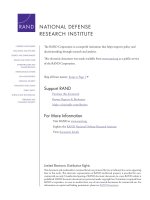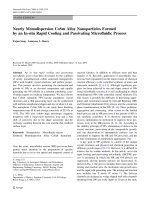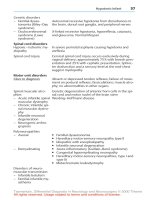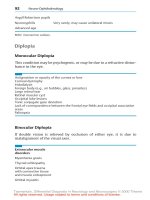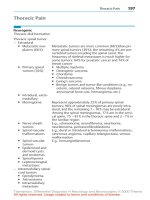Rapid neurology and neurosurgery
Bạn đang xem bản rút gọn của tài liệu. Xem và tải ngay bản đầy đủ của tài liệu tại đây (2.22 MB, 204 trang )
Rapid
Neurology and
Neurosurgery
Rapid
Neurology and
Neurosurgery
Kumar Abhinav
BSc (Hons.), MBBS, MRCS (Eng)
Specialty Registrar
Department of Neurosurgery
Frenchay Hospital
Bristol, UK
Richard Edwards
BSc (Hons.), MBBS, FRCS (Neuro.Surg), MD
Consultant Neurosurgeon
& Senior Clinical Lecturer (University of Bristol)
Department of Neurosurgery
Frenchay Hospital
Bristol, UK
Alan Whone
MBChB, MRCP, PhD
Senior Lecturer (University of Bristol) & Consultant Neurologist
Department of Neurology
Frenchay Hospital
Bristol, UK
This edition first published 2012 # 2012 by John Wiley & Sons, Ltd
Wiley-Blackwell is an imprint of John Wiley & Sons, formed by the merger of Wiley’s global Scientific,
Technical and Medical business with Blackwell Publishing.
Registered office: John Wiley & Sons, Ltd, The Atrium, Southern Gate, Chichester, West Sussex, PO19
8SQ, UK
Editorial offices: 9600 Garsington Road, Oxford, OX4 2DQ, UK
The Atrium, Southern Gate, Chichester, West Sussex, PO19 8SQ, UK
111 River Street, Hoboken, NJ 07030-5774, USA
For details of our global editorial offices, for customer services and for information about how
to apply for permission to reuse the copyright material in this book please see our website at
www.wiley.com/wiley-blackwell.
The right of the author to be identified as the author of this work has been asserted in accordance with
the UK Copyright, Designs and Patents Act 1988.
All rights reserved. No part of this publication may be reproduced, stored in a retrieval system, or
transmitted, in any form or by any means, electronic, mechanical, photocopying, recording or otherwise,
except as permitted by the UK Copyright, Designs and Patents Act 1988, without the prior permission
of the publisher.
Designations used by companies to distinguish their products are often claimed as trademarks. All brand
names and product names used in this book are trade names, service marks, trademarks or registered
trademarks of their respective owners. The publisher is not associated with any product or vendor
mentioned in this book. This publication is designed to provide accurate and authoritative information in
regard to the subject matter covered. It is sold on the understanding that the publisher is not engaged in
rendering professional services. If professional advice or other expert assistance is required, the services of
a competent professional should be sought.
Library of Congress Cataloging-in-Publication Data
Abhinav, Kumar.
Rapid neurology and neurosurgery / Kumar Abhinav, Richard Edwards, Alan Whone.
p. ; cm. – (Rapid series)
Includes bibliographical references and index.
ISBN 978-0-470-65443-9 (pbk. :alk. paper)
I. Edwards, Richard (Richard John) II. Whone, Alan. III. Title. IV. Series: Rapid series.
[DNLM: 1. Nervous System Diseases–Handbooks. 2. Neurosurgical Procedures–Handbooks.
3. Trauma, Nervous System–Handbooks. WL 39]
616.80076–dc23
2012009836
A catalogue record for this book is available from the British Library.
Wiley also publishes its books in a variety of electronic formats. Some content that appears in print may
not be available in electronic books.
Cover image: iStock # Sebastian Kaulitzki
Cover design by Fortiori Design
Set in 7.5/9.5pt Frutiger-Light by Thomson Digital, Noida, India
1 2012
Contents
List of Abbreviations, vii
Preface, xi
Acknowledgements, xiii
PART I The basics
1 About this book and how to use it, 3
2 Basic neuroanatomy, 4
3 Neurological history, examination, signs and localisation, 7
4 Neurological investigations, 21
PART II Complaints: Face-to-face with the patient
5 Headache, 31
6 Blackouts, 34
7 Visual disturbances, 36
8 Dizziness and vertigo, 39
9 Weak legs, 41
10 Numbness and sensory disturbance, 44
11 Gait assessment and disturbance, 46
PART III Conditions: Applying the basics
12 Headache, 51
13 Transient ischaemic attacks (TIAs), 55
14 Stroke I: Thromboembolic stroke and syndromes, 59
15 Stroke II: Intracerebral haemorrhage, 65
16 Stroke III: Subarachnoid haemorrhage, 68
17 Epilepsy, 75
18 Multiple sclerosis, 80
19 Parkinson’s disease and other related syndromes, 84
20 Other movement disorders, 88
21 Central nervous system infections: Meningitis, 91
22 Central nervous system infections: Cerebral abscess, 94
23 Radiculopathy and disc herniation, 97
24 Peripheral neuropathies’ syndromes, 100
25 Common peripheral nerve lesions: Mononeuropathies, 104
26 Motor neurone disease (MND), 108
27 Myasthenia gravis and Lambert–Eaton myasthenic syndrome, 111
28 Diseases of the muscle, 114
29 Alzheimer’s disease and other dementia syndromes, 118
30 Raised intracranial pressure and herniation syndromes, 122
31 Coma and brainstem death, 127
32 Head injury: General approach and management, 130
33 Head injury: Subdural haematoma, skull fractures and contusions, 135
34 Head injury: Extradural haematoma, 141
35 Spinal injuries and spinal cord syndromes, 144
36 CNS neoplasia, 151
37 Hydrocephalus, 155
Appendices
Appendix 1 Management of status epilepticus (SE), 163
Appendix 2 Glasgow Coma Scale (GCS), 164
Appendix 3 Primary neuroepithelial tumours of the central nervous system, 166
Appendix 4 Other tumours affecting the central nervous system, 173
Index, 181
vi Contents
List of Abbreviations
ABC Airways and breathing and circulation
AD Alzheimer’s disease
ADEM Acute disseminated encephalomyelitis
ADHD Attention deficit hyperactivity disorder
AED Antiepileptic drug
AF Atrial fibrillation
ALS Amyotrophic lateral sclerosis
APP Amyloid precursor protein
ASDH Acute subdural haematoma
AVMs Arteriovenous malformations
BNF British National Formulary
BPV Benign positional vertigo
CAA Cerebral amyloid angiopathy
CADASIL Cerebral autosomal dominant arteriopathy with subcortical
infarcts and leukoencephalopathy
CBF Cerebral blood flow
CES Cauda equina syndrome
CIDP Chronic inflammatory demyelinating polyneuropathy
CMAP Compound muscle action potential
CN Cranial nerve
CNS Central nervous system
CPP Cerebral perfusion pressure
CSDH Chronic subdural haematoma
CT Computed tomography
CTA CT angiography
CTS Carpal tunnel syndrome
CVR Cerebral vascular resistance
DAI Diffuse axonal injury
DBS Deep brain stimulation
DIND Delayed ischaemic neurological deficit
DVLA Driver and Vehicle Licensing Agency
DVT Deep venous thrombosis
EEG Electroencephalogram
EMG Electromyography
EMQ Extended matching questions
ET Essential tremor
ETV Endoscopic third ventriculostomy
EVD External ventricular drain
FTD Frontotemporal dementia
FVC Forced vital capacity
GCA Giant cell arteritis
GBM Glioblastoma multiforme
GBS Guillian–Barr
e syndrome
GCS Glasgow Coma Scale
GTC Generalised tonic–clonic
HACE High altitude cerebral oedema
ICH Intracerebral haemorrhage
ICP Intracranial pressure
IIH Idiopathic intracranial hypertension
INO Internuclear opthalmoplegia
IVIG Intravenous immunoglobulin
LACS Lacunar stroke
LEMS Lambert–Eaton myasthenic syndrome
LBD Lewy body dementia
LMN Lower motor neurone
LOC Loss of consciousness
LP Lumbar puncture
LP Lumboperitoneal
MAP Mean arterial pressure
MCI Mild cognitive impairment
MCQ Multiple choice questions
MDT Multidisciplinary team
MG Myasthenia gravis
MND Motor neurone disease
MRA MR angiography
MRC Medical Research Council
MRI Magnetic Resonance Imaging
MS Multiple sclerosis
MUPs Motor unit potentials
NAHI Non-accidental head injury
NCS Nerve conduction studies
NMJ Neuromuscular junction
NPH Normal pressure hydrocephalus
OCSP Oxford Community Stroke Project
OSCE Objective Structured Clinical Examinations
PACS Partial anterior circulation stroke
PBP Progressive bulbar palsy
PCC Prothrombin complex concentrate
PD Parkinson’s disease
PE Pulmonary embolism
PEG Percutaneous endoscopic gastrostomy
viii List of Abbreviations
PFO Patent foramen ovale
PLS Primary lateral sclerosis
PMA Progressive muscular atrophy
PNS Peripheral nervous system
POCS Posterior circulation stroke
PPMS Primary progressive multiple sclerosis
PRES Posterior reversible encephalopathy syndrome
PTA Posttraumatic amnesia
RAPD Relative afferent pupillary defect
RAS Reticular activating system
REZ Root entry zone
RRMS Relapsing/remitting multiple sclerosis
RTA Road traffic accidents
SACD Subacute combined degeneration of the cord
SAH Subarachnoid haemorrhage
SCI Spinal cord injury
SCM Sternocleidomastoid
SE Status epilepticus
SEM Spinal extradural metastases
SPMS Secondary progressive multiple sclerosis
TACS Total anterior circulation stroke
TBI Traumatic brain injury
TIAs Transient ischaemic attacks
TN Trigeminal neuralgia
UMN Upper motor neurone
VA Ventriculoatrial
VP Ventriculoperitoneal
List of Abbreviations ix
Preface
My late grandfather, a university professor, used to talk about the so-called ‘ideal’ students,
who read extensively on a topic prior to attending the relevant lec ture, made their own
‘notes’ in their own ‘words’ in a summarised fashion, which they subsequently memorised
in the lead up to the exams. This inspirational philosophy with respect to teaching and the
‘ideal’ learning method can be difficult to adhere to as a modern medical student, where
the ever-increasing breadth of the curriculum makes it difficult to both identify the perti-
nent information and then assimilate it in preparation for the exams.
Our objective was to put together a book in a condensed format, which gave the neces-
sary basic information for building a solid foundation in neurolog y and neurosurgery
required by medical students and junior doctors, and then followed it up with sections on
presenting complaints and all the key clinical conditions. This book aims to simplify informa-
tion in specialties traditionally considered ‘difficult’, to which medical students have variable
and usually limited ex posure, and to facilitate focused exam preparation. We really hope
differential diagnoses tables, a consistent feature across this book, are helpful particularly
for OSCE and EMQ sections of the exam and are used to refresh knowledge from other
cross-referenced chapters during revision.
We sincerely hope this easy-to-use and concise book with ample practical information is
useful for exams and as a reference guide on the wards and clinics f or medical students,
junior doctors and other health professionals in neurology and neurosurgery.
Kumar Abhinav
Richard Edwards
Alan Whone
Acknowledgements
We are indebted to all those who provided helpful advice at different stages of the produc-
tion of the book. We a re also grateful to the medical students and junior doctors who
provided invaluable advice regarding improving the contents of the book. Specifically, we
would like to acknowledge the following at Frenchay Hospital, Bristol: Mr Kristian Aquilina,
Consultant Neurosurgeon for authoring the chapters on me ningitis and cerebral abscess;
Dr Philip Clatworthy, Specialist registrar in Neurology and Stroke Medicine, for his contri-
bution towar ds the chapters on transient ischaemic attacks and thromb oembol ic stroke
and syndromes, and Mr Devindra Ramnarine, Senior registrar in Neurosurgery, for his feed-
back regarding the chapter on radiculopathy and disc herniation. We would further like to
thank all our colleagues at the Wiley-Blackwell: in particular, Martin Davies for his support
through the initial stages of the book proposal and Laura Murphy for her guidance through
the preparation of the manuscript. Finally, we are immensely thankful to our partners and
families for their encouragement and patience through t he preparation of the book and
particularly to Melanie Yoogalingam for her help and support throughout this endeavour.
Part I
The basics

